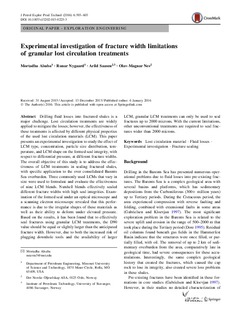| dc.contributor.author | Alsaba, Mortadha | |
| dc.contributor.author | Nygaard, Runar | |
| dc.contributor.author | Saasen, Arild | |
| dc.contributor.author | Nes, Olav-Magnar | |
| dc.date.accessioned | 2017-04-11T10:58:01Z | |
| dc.date.available | 2017-04-11T10:58:01Z | |
| dc.date.issued | 2016-01 | |
| dc.identifier.citation | Alsaba, M. et al. (2016) Experimental investigation of fracture width limitations of granular lost circulation treatments. Journal of Petroleum Exploration and Production Technology, 6(4), pp. 593-603 | nb_NO |
| dc.identifier.uri | http://hdl.handle.net/11250/2437436 | |
| dc.description.abstract | Drilling fluid losses into fractured shales is a major challenge. Lost circulation treatments are widely applied to mitigate the losses; however, the effectiveness of these treatments is affected by different physical properties of the used lost circulation materials (LCM). This paper presents an experimental investigation to study the effect of LCM type, concentration, particle size distribution, temperature, and LCM shape on the formed seal integrity, with respect to differential pressure, at different fracture widths. The overall objective of this study is to address the effectiveness of LCM treatments in sealing fractured shales, with specific application to the over consolidated Barents Sea overburden. Three commonly used LCMs that vary in size were used to formulate and evaluate the effectiveness of nine LCM blends. Nutshell blends effectively sealed different fracture widths with high seal integrities. Examination of the formed seal under an optical microscope and a scanning electron microscope revealed that this performance is due to the irregular shapes of these materials as well as their ability to deform under elevated pressure. Based on the results, it has been found that to effectively seal fractures using granular LCM treatments, the D90 value should be equal or slightly larger than the anticipated fracture width. However, due to both the increased risk of plugging downhole tools and the availability of larger LCM, granular LCM treatments can only be used to seal fractures up to 2000 microns. With the current limitations, other unconventional treatments are required to seal fractures wider than 2000 microns. | nb_NO |
| dc.language.iso | eng | nb_NO |
| dc.publisher | Springer | nb_NO |
| dc.rights | Navngivelse 4.0 Internasjonal | * |
| dc.rights.uri | http://creativecommons.org/licenses/by/4.0/deed.no | * |
| dc.subject | lost circulation material | nb_NO |
| dc.subject | fluid losses | nb_NO |
| dc.subject | experimental investigation | nb_NO |
| dc.subject | fracture sealing | nb_NO |
| dc.title | Experimental investigation of fracture width limitations of granular lost circulation treatments | nb_NO |
| dc.type | Journal article | nb_NO |
| dc.type | Peer reviewed | nb_NO |
| dc.rights.holder | © The Author(s) 2016. | nb_NO |
| dc.subject.nsi | VDP::Teknologi: 500::Berg‑ og petroleumsfag: 510::Petroleumsteknologi: 512 | nb_NO |
| dc.source.pagenumber | 593–603 | nb_NO |
| dc.source.volume | 6 | nb_NO |
| dc.source.journal | Journal of Petroleum Exploration and Production Technology | nb_NO |
| dc.source.issue | 4 | nb_NO |
| dc.identifier.doi | 10.1007/s13202-015-0225-3 | |

